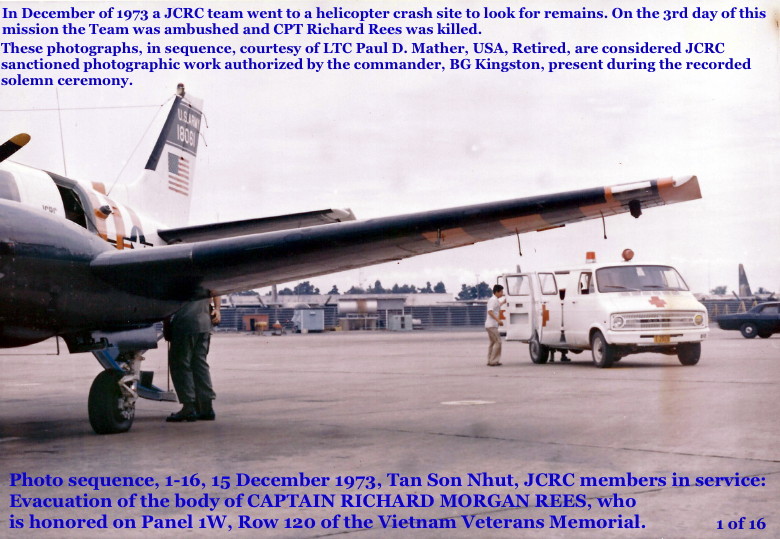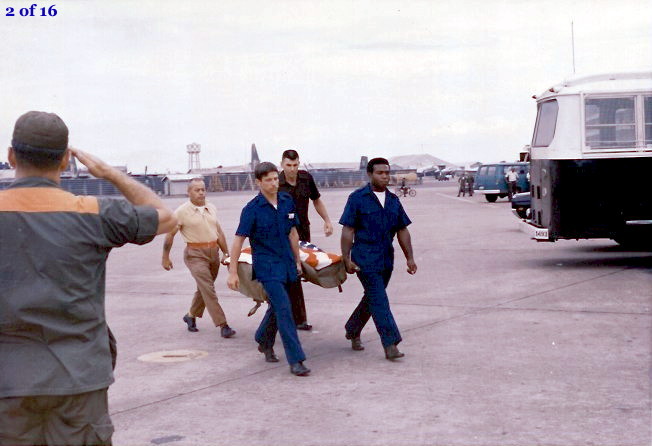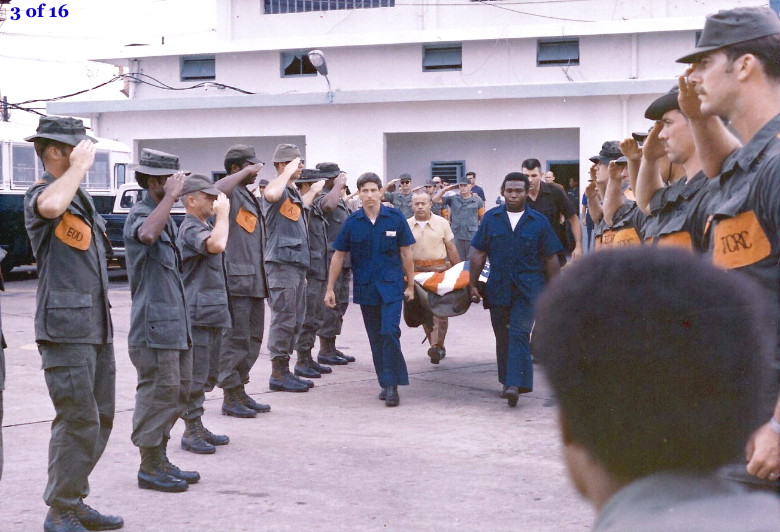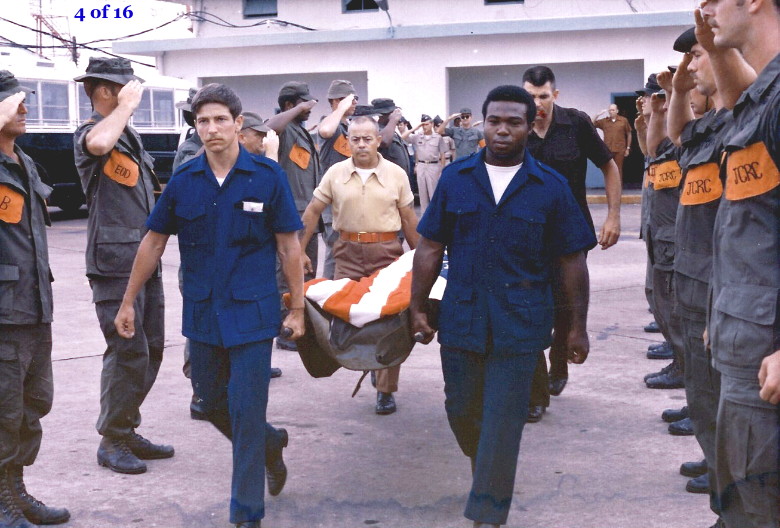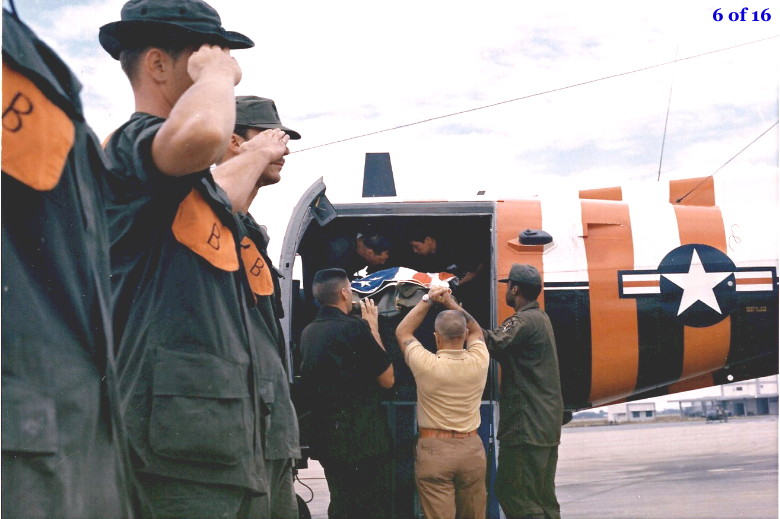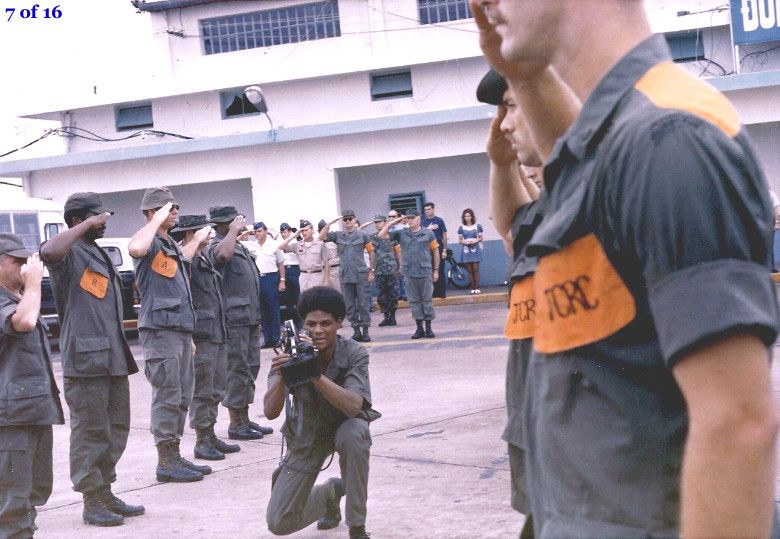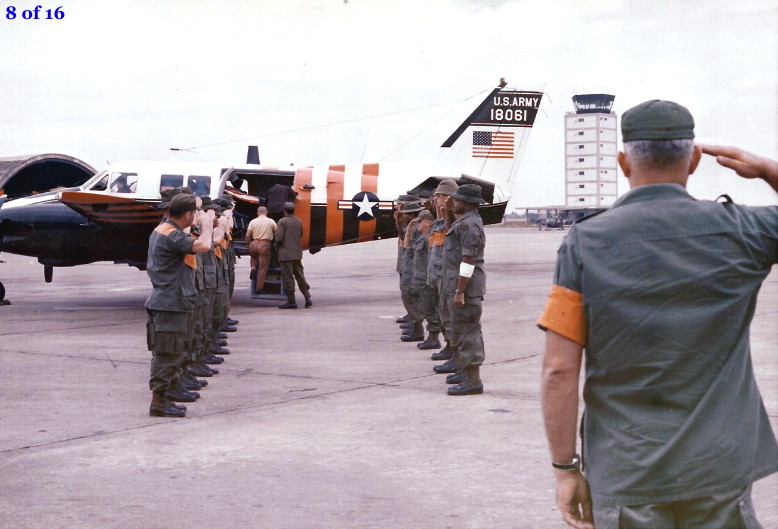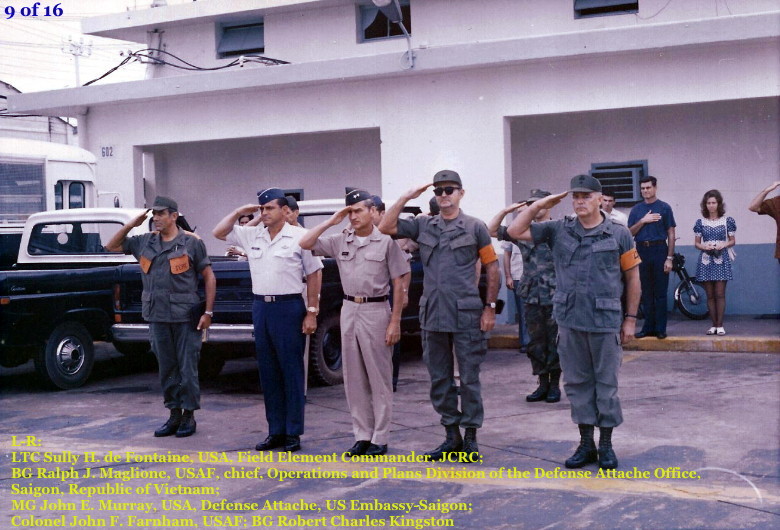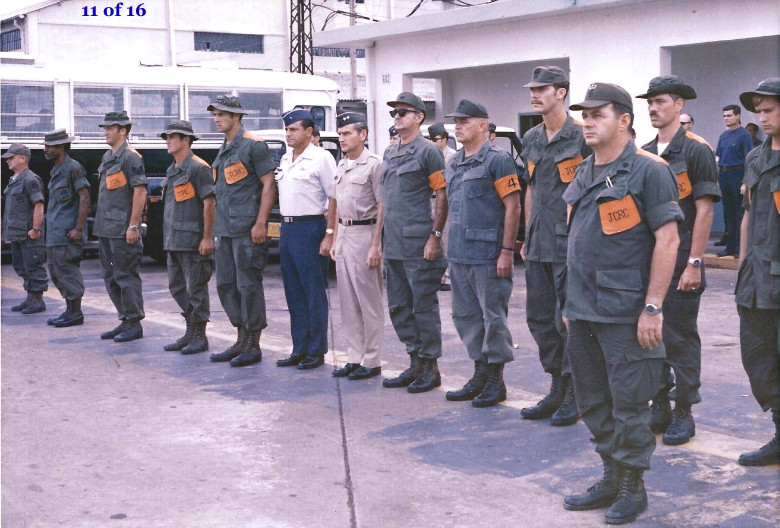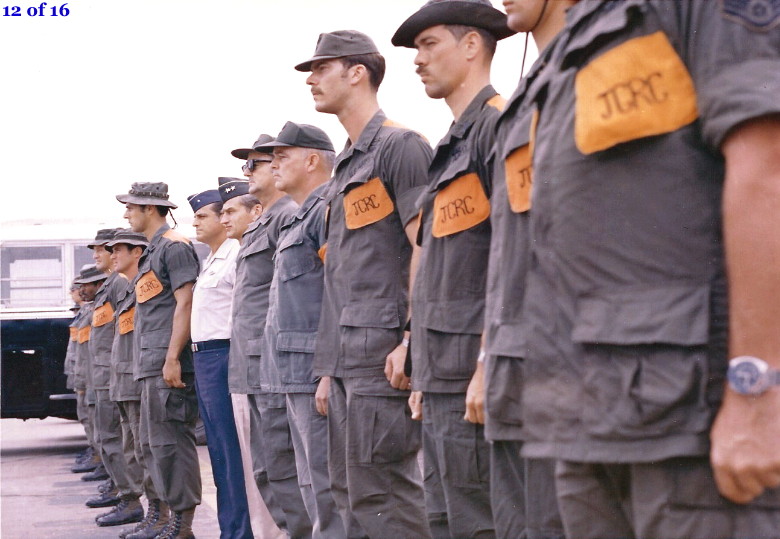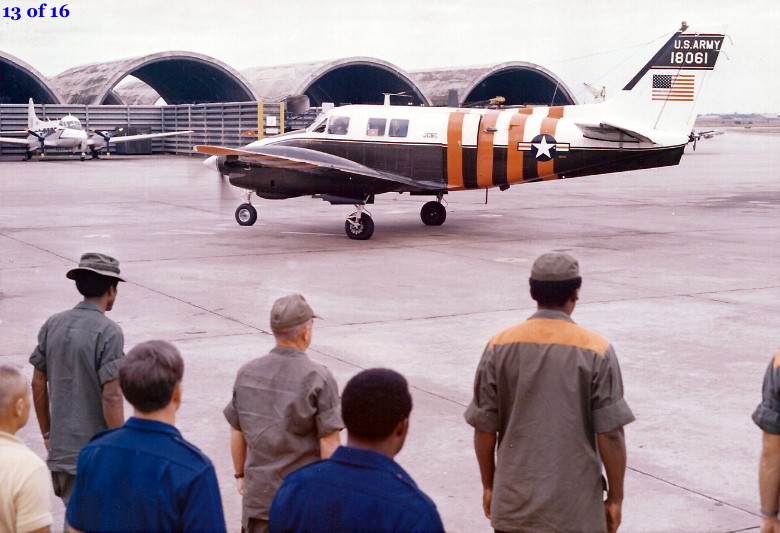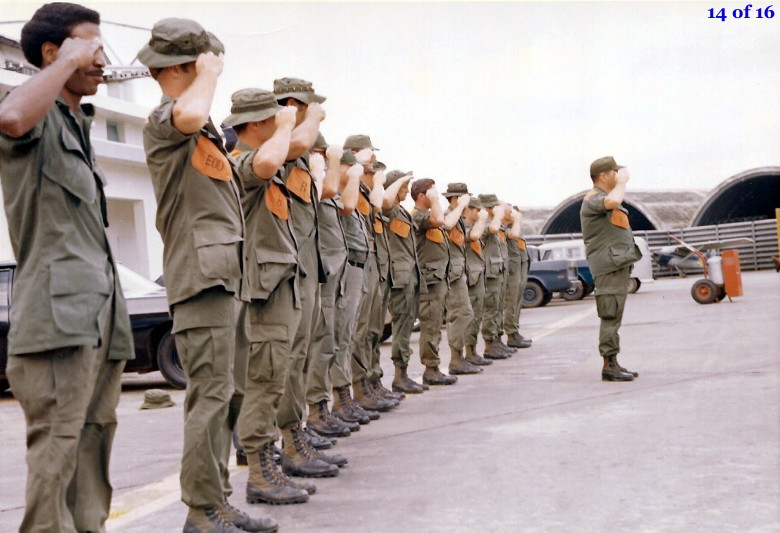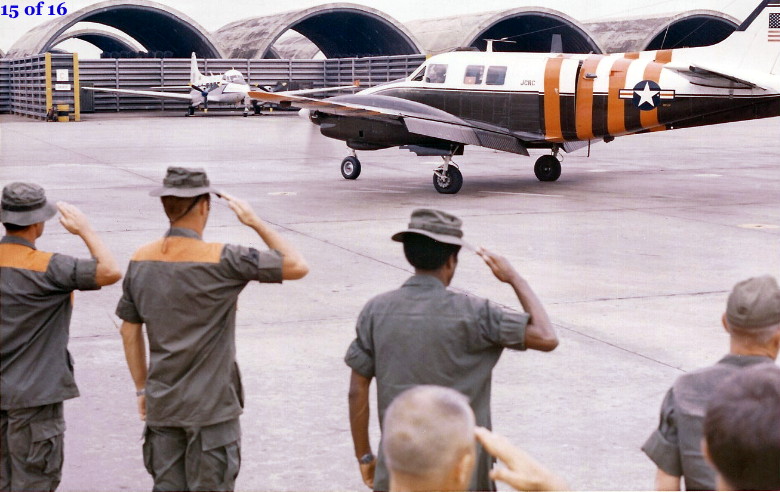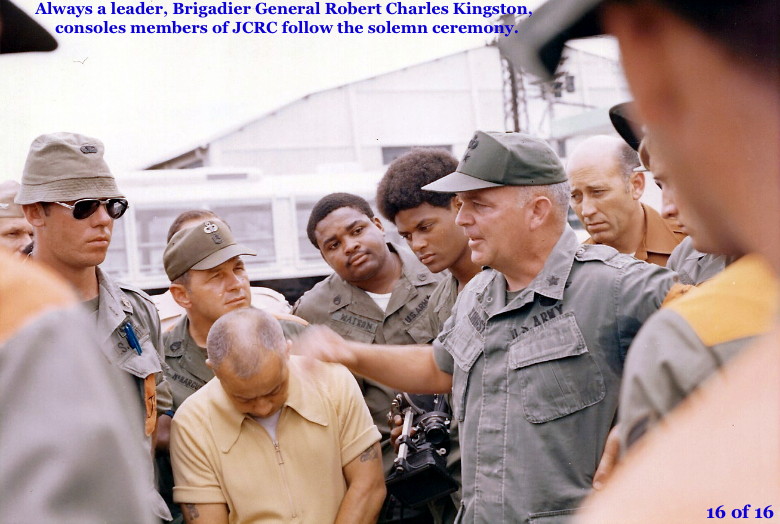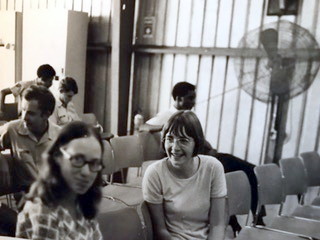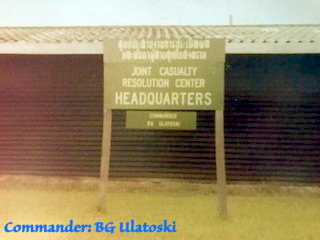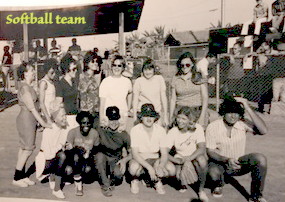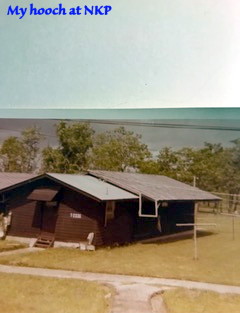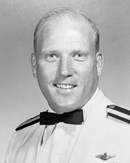JOINT CASUALTY RESOLUTION CENTER (JCRC)
FLIGHT SUPPORT SECTION,
70th AVIATION DETACHMENT,
1974–75:
By Donald M. Ricks, Webmaster
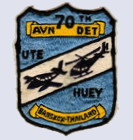
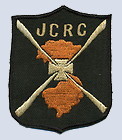
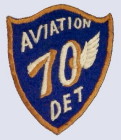
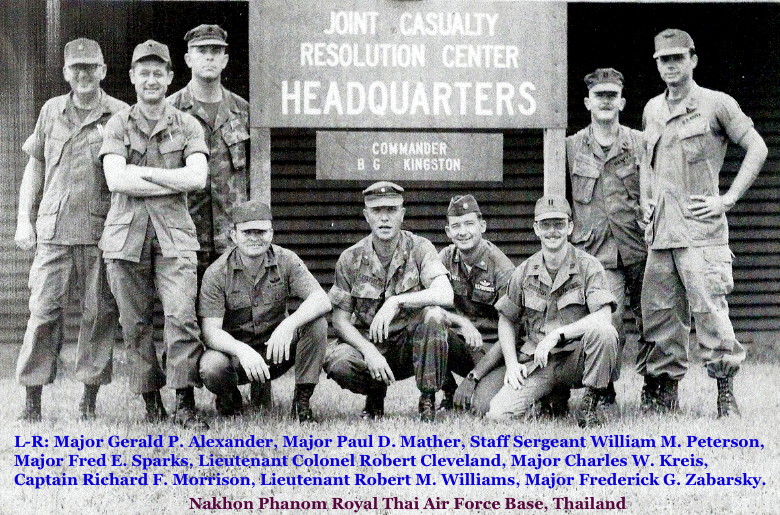
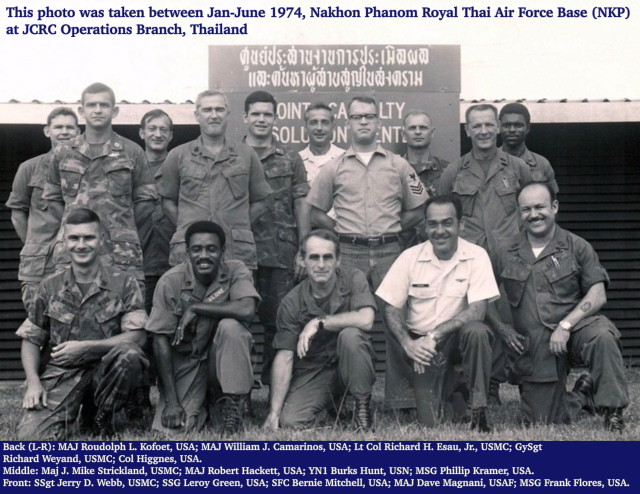
Wikipedia’s web site reports that “in [23] January 1973, Brigadier General Robert Charles Kingston assumed command of the Joint Casualty Resolution Center (JCRC) in Nakhon Phanom, Thailand. Upon his return to the United States in 1974, he assumed duties as Assistant Division Commander of the First Infantry Division and was promoted to Major General in September 1975.” Another more historically inclusive site provides a better overview of BG Kingston’s roll in JCRC. MIAFACTS.ORG has a more in–depth discussion about the early days but little of what you will find in this JCRC FSS web site’s discussion. The activities of the personnel who actually did the hard work of this agency is not well known. Over time, my goal is to record the names of those who formed the teams and served in administrative positions that assisted in the direction of JCRC. BR Kingston served as JCRC commander until 18 December 1973.
Headquarters, Joint Casualty Resolution Center unit roster, dated 23 August 1973, also contains a roster of personnel assigned to the JCRC Flight Support Section, 70th Aviation Detachment:
- Leon K. Butler, 1LT, Section Commander
- Jerry S. Register, CW2, Pilot
- Robert E. Sanders, CW2, Pilot
- Robert E. Stamper, CW2, Pilot
- Tuncil Robbins, SFC, Aircraft Repair Supervisor
- Paul E. Lewis, SP6, Technical Inspector
- Richard L. Ala, SP5, U21 Crew Chief
- Roger Moody, SP5, Senior Flight Coordinator
- Woodrow O. Roselock, SP5, U21 Crew Chief
- David E. Berger, SP4, Supply Clerk
- Michael S. Cox, SP4, U8/U21 Crew Chief
- Joseph J. Desjardins, Clery Typist, U8/U21 Crew Chief
- Barry W. Hamblin, SP4, Clerk Typist
- Michael W. Nygaard, SP4, Avionics Technician
- Theodore O’Neil, SP4, U8/U21 Crew Chief
- James A. Davis, SP4, Avionics Mechanic
- Kenneth W. Carrier, PVT, Airplane Repairman
MURDER AND RECOVERY OF CAPTAIN RICHARD MORGAN REES, JCRC FIELD TEAM LEADER:
On 15 December 1973, following what was discribed by an American official as murder of a JCRC team leader on the ground in South Vietrnam, procedures for recovery operations drastically changed. The account of this event can be found in documents at this site. One or more of the above listed pilots flew the JCRC recovery aircraft in this following photo, courtesy of a publication by LTC (Ret.) Paul Mather:
JCRC AFTER BG KINGSTON:
From 18 December 1973 to 8 January 1974, the JCRC was commanded by Colonel Vincent A. Di Mauro, USAF. On 8 January 1974, Brigadier General Joseph R. Ulatoski, USA, assumed command. JCRC was also given control over a Flight Support Section of three US Army U–21 aircraft, assigned to JCRC from the 70th Aviation Detachment (see page 24 of the following document). These aircraft met JCRC requirements for communications relay,
transport of remains, and other CR-related administration requirements.
BG Ulatoski departed, concurrent with the change in command policy, in early December 1974 and was replaced by his former deputy, Colonel John P. Vollmer. (Source: Phone conversation with BG Ulatoski, March 2014.)
SP5 Linda L. Henson:
I was stationed at NKP, Thailand from 16 Oct 1973 to 7 Oct 1974. I was assigned to USSAG from 16 Oct 1973 until 19 Feb 1974. My job as a clerk typist was phased out due to the downsizing of the USAF stationed there. I was then assigned to HQ, JCRC on 19 Feb 1974. I worked in the Casualty Data Division. I was a Administrative Specialist and a Classified Material Clerk. I worked under MSG Robert E. Thompson II , USA , until he left. Then my NCOIC was a YN1 Brian W. Tinagero, USN. My Commander was a BG Joseph R. Ulatoski until I left. My name was SP5 Linda L. Henson back then. I have great memories of Thailand since it was my very first overseas assignment. Really like the warm weather. I didnít like the the little white truck that came around every night spraying the air with a white pesticide. Years later I found out the base was sprayed with Agent Orange around the perimeter. I used to walk, run or ride my bike on the perimeter road looking up at the guard towers with Thai soldiers in them.
Before Thailand I was stationed at Fort McClellan at the WAC Training Center and School. Then I was sent to Thailand. After Thailand, I was sent to Heidelberg, West Germany, Office of the Deputy Chief of Staff, Intelligence and for the ODCS Operations; then back to the states to Fort Lee , Virginia, with the 240th Quartermaster Battalion; then back to Heidelberg, W. Germany, with 1st PERSCOM; then back to states to Fort Eustis, Virginia, Transportation School; then to Inspector General School at Fort Belvoir, Virginia, and my last assignment back to W. Germany in Schwaebisch Gmuend, W. Germany with the 56th Field Artillery Battalion. My first assignment was to the old Walter Reed Hospital in D.C. So, my 21 years in the US Army working in the Administrative and Personnel field has covered the Medical, Quartermaster, Transportation, Intelligence, and Artillery fields.
While I was at Fort Lee, Virginia, I worked as the 240th Quartermaster Battalion’s Admin specialist, so I got to file a lot of Army Regulations and Pamphlet. It was in one of the pamphlet that I saw where JCRC personnel got the Meritorious Unit Commendation. Since I was serving there at the time of the citation, I submitted paperwork to my personnel people and I got the MUC Ribbon.Photos by Linda Henson:
In the photo taken of softball players, you can see three are men dressed as women to make up a team. I didn't take any names of them like I did of the 1st photo. Of the softball players, I am the 6th person from the left in 2d row. To my left and right are two of my fellow WACs that traveled to Thailand also. One on left of me was a Nancy Dorman and on the right was a Marilyn Felts. We were stationed at Fort McClellan, Alabama, together.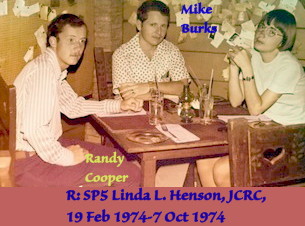
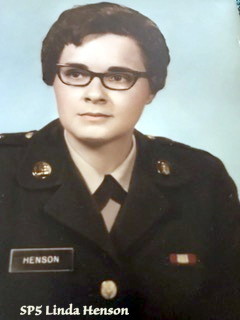
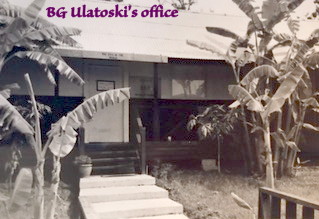
In late August of 1974, CPT Donald M. Ricks assumed command of the JCRC Flight Support Section (JCRC FSS). Here it is useful to review a rambling, less that chronological document that essentially covers the entire operational history of JCRC, until mid–1974, especially pages 13 through 25 with respect to the flight support section:
The above historical report period ends about June 1974.
“In mid–1974, "CINCPAC made other recommendations regarding the staffing of the JCRC, to include reduction of the number of JCRC field teams from 11 to four, a corresponding reduction in JCRC staff members, reduction of the rank of the JCRC Commander’s billet from Brigadier General to Colonel, and physical movement of the JCRC organization from Nakhon Phanom Air Base to Camp Samae San in southeast Thailand. The Joint Chiefs of Staff (JCS) in Washington, DC, received these recommendations but, aware of the political sensitivities involved, concluded that making any sweeping organizational changes at this time would be premature. The JCS did not wish to take any action which might be interpreted as decreasing the emphasis of the casualty resolution effort, or of abandoning the JCRC mission. They did, however, approve the movement of the JCRC to Camp Samae San, since military activities at Nakhon Phanom Air Base were gradually being closed down. This move eventually took place in January 1975.
Meanwhile, the military situation throughout Indochina continued to deteriorate. The FPJMT talks were essentially stalemated, and the DRV and PRG representatives no longer made any pretense of pursuing efforts to carry out either the terms of Article 8(b), or of any other portion of the Paris Accords, including those dealing with the cessation of hostilities. Like a big deadly chess game, the North Vietnamese relentlessly pushed their men into place for the final checkmate. By the end of 1974, an estimated 300,000 North Vietnamese Army troops were in South Vietnam, an increase of over 90,000 since the date of the cease-fire. In addition, these troops were supported by an increasing number of tanks, heavy artillery, and Surface–to–Air (SAM) missiles. The North Vietnamese had constructed and improved over 1,000 miles of roadways to facilitate their infiltration of men and supplies into the south, and had turned the city of Dong Ha into a major port and stockpile site. Hope for the successful conclusion of any meaningful effort to resolve the American casualties lost in South Vietnam was rapidly fading.
As this deterioration continued into the first months of 1975, the JCRC effort in Vietnam ground to a halt. The public communication program ceased, as did other attempts to solicit assistance from officials and community leaders. Planning for site investigations was put on hold, and the JCRC headquarters in Thailand devoted itself more and more to analytical efforts. Our South Vietnamese allies, preoccupied as they were with their own survival, could no longer devote any energy or resources to assisting the United States in resolving the fate of American casualties.
By March 1975, all offensive momentum had turned in favor of the communist forces. Much of the Central Highlands had fallen or was under siege, and the northern provinces of South Vietnam were falling in turn. The North Vietnamese war machine ground its way southward, pushing ahead of it a wave of panic designed to break the resistance of Saigon. All United States efforts at casualty resolution in South Vietnam had necessarily ceased, and the JCRC liaison personnel were co-opted by the American Defense Attache in Saigon to assist in responding to the approaching debacle. Several personnel were detailed to assist with the humanitarian aspects of the flood of Vietnamese refugees who were pouring into the Saigon area from up-country areas which the communist forces had already overrun. Other JCRC personnel were assigned to assist in preparing for the evacuation of both American and Vietnamese personnel.
In the midst of this frantic activity, in early April a USAF C-5 aircraft crashed at Tan Son Nhut Air Base near Saigon killing many of the passengers and crew aboard, including over 100 Vietnamese orphans who were being evacuated to the United States. The Defense Attache, taking advantage of the availability and expertise of the JCRC and the Army's Central Identification Laboratory, directed that they assume responsibility for the recovery and disposition of the bodies of those killed in the crash. Thus the JCRC and Central Identification Laboratory personnel conducted their last and saddest casualty operation in South Vietnam prior to the final evacuation.
On 21 April, the JCRC Commander Colonel John P. Vollmer, directed that the remaining JCRC personnel still in Vietnam be evacuated. Colonel Vollmer had several overriding concerns, the first being the immediate safety of his personnel. Second, however, was his concern that should JCRC personnel remain in Vietnam to the last, they would ultimately become involved in the renewed conflict, thus distorting the image of the JCRC which he and previous commanders had sought to maintain: that theJCRC was strictly a humanitarian organization, overt in all its activities, and not to be involved in combat of any form. An Army U-21 aircraft was dispatched from Thailand, and the last of the JCRC liaison office personnel were loaded aboard. The plane returned across Cambodia to Thailand where the liaison office members rejoined the JCRC headquarters at Camp Samae San.”
(Source: Footnote entry 17: Two JCRC personnel, Captain George Petrie and Captain Tony Wood, remained in Saigon to the last. During the weeks before the collapse, they had been given vital roles in the planning and implementing of the final ground and helicopter evacuation from selected sites throughout Saigon. Consequently, in a paperwork ruse to maintain JCRC's non-combat image, Petrie and Wood were administratively separated from the JCRC and assigned to the Defense Attache Office. Their heroic activities during this period would make a book in itself. So also would the activity of another JCRC member, Captain Roger Urbaniak, who was evacuated from Saigon to Thailand on 21 April, signed out on leave, then, unbeknownst to the JCRC Commander, returned aboard an aircraft back to Saigon two days later to assist in the evacuation of the JCRC Liaison Office Vietnamese staff members.
Document source: Paris Peace Accords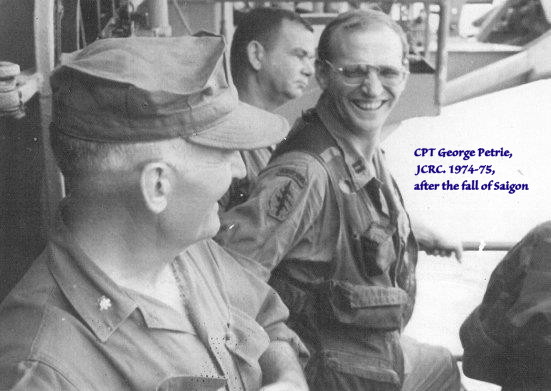
Initially the unit duty station was at Nakhon Phanom, Thailand (NKP), where flight operations originated, but in late January 1975 events caused a change in the units duty station to U–Tapao Royal Thai Navy Airbase,Thailand. Earlier the Central Identification Laboratory (CIL) was established at Camp Samae San sometime in late 1973 or 1974, I believe. JCRC FSS relocated to Samae San and flew missions from that base into South Vietnam in support of the JCRC MIA/POW mission and essentially stood down from further out of country flights when Saigon fell on 30 April 1975.
It was about this date that the Vietnamese Air Force knew it was over and flew en masse into Thailand and other locations in a mixture of aircraft, heavily loaded with more people than the aircraft normally accommodated, and most of the FSS personnel, including the commander, helped process the Vietnamese who fled. 70th Aviation Detachment pilots and crews helped recover many of the aircraft scattered throughout southern Thailand. This overview extract comes from aWikipedia Web sitesource.In the final evacuation, over a hundred VNAF aircraft arrived in Thailand, including twenty–six F-5s, eight A–37s. eleven A–1s, six C–130s. thirteen C–47s, five C–7s, and three AC–119s. Additionally close to 100 VNAF helicopters landed on U.S. ships off the coast, although at least half were jettisoned. One O–1 managed to land on the USS Midway, which carried a South Vietnamese major, his wife, and five children. On 30 April 1975, Saigon fell and all remaining South Vietnamese forces were ordered to surrender.The unit was also at U–Tapao, during 12–15 May 1975, when the MAYAGUEZ INCIDENT AT KOH TANG took place. A pilot from the 70th Aviation Detachment at Bangkok flew the actual recon mission just before the assault on the ship. One of the Command Aircraft Company pilots who served with me in 1970 was that pilot:
For the VNAF, thirty–five long years of war had come to an end. Following the war, Tan Son Nhut Air Base was taken over as a base for the Vietnam People’s Air Force.I DO remember you from BOTH our CAC and Thailand days, and especially the post–Vietnam aircraft “scramble” at Utapao. Also, I was the PIC on that Mayaguez recon flight. That truly was an interesting time.The section mostly flew missions into South Vietnam, before Saigon fell. Aircraft were usually loaded with search teams members and their support footlockers aboard, or the JCRC commander BG Joseph Ulatoski and his staff, with no support provisions nor possibility of search and rescue in the event of an emergency. The mission was strictly to perform an humanitarian mission.
CPT Craig Herget, 70th Avn Det
As Saigon began to come under critical threat of siege, all assigned pilots and crew members flew missions into South Vietnam to evacuate personnel and equipment, up to the last days before the routing of the government of South Vietnam. Two of our aircraft were repainted with a heavier IR–reflective paint scheme, due to an increased anti–aircraft missle threat. Initially, section aircraft were instructed to fly above FL180, while crossing Cambodia to avoid missile activity, but as conditions deteriorated the route changed to include only a “feet wet” route via Fish Intersection (located due west of Saigon in the gulf in order to avoid overflight of Cambodia). The unit also flew one mission into Phnom Penh, Cambodia, to deliver a CIA agent during the actual siege of the capitol and as mortars fell on the airport (the PIC was CPT Ricks and the copilot believed to be CW2 Myron G. Schneider). The flight then continued on to Saigon to further assist in the evacuation effort before returning to Thailand. Flight Section Operations (call sign RALLY, the name given by CWO Lyle Real) throughout this period were conducted successful and without damage or injury to section personnel and aircraft.
The following would be history for JPAC (formerly JCRC in Thailand until 1975):

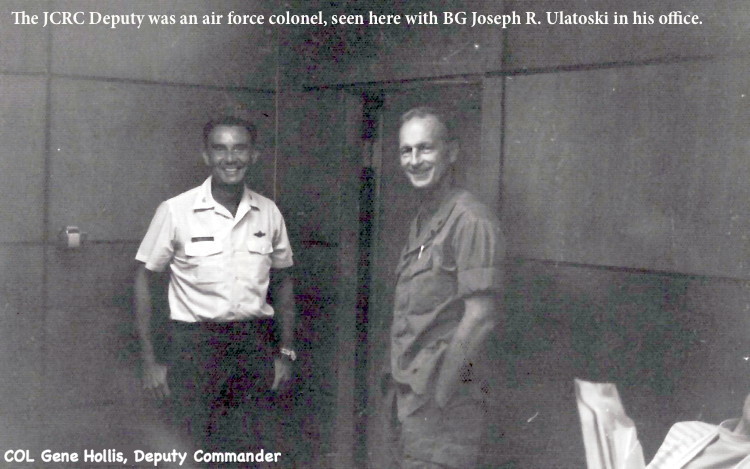
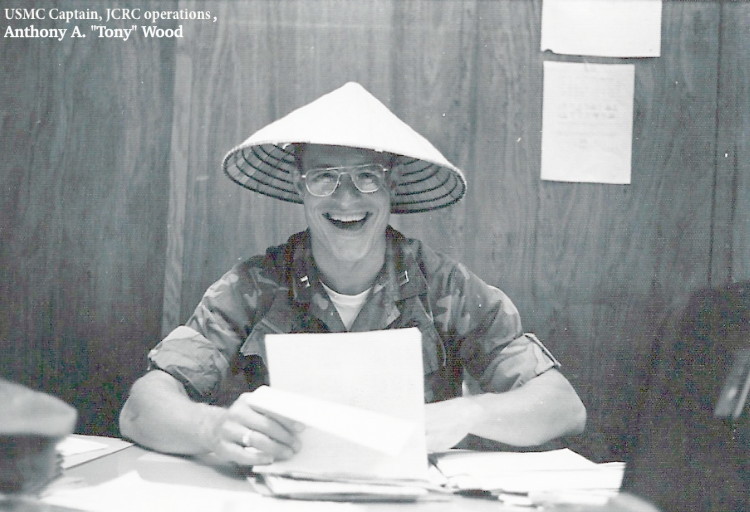
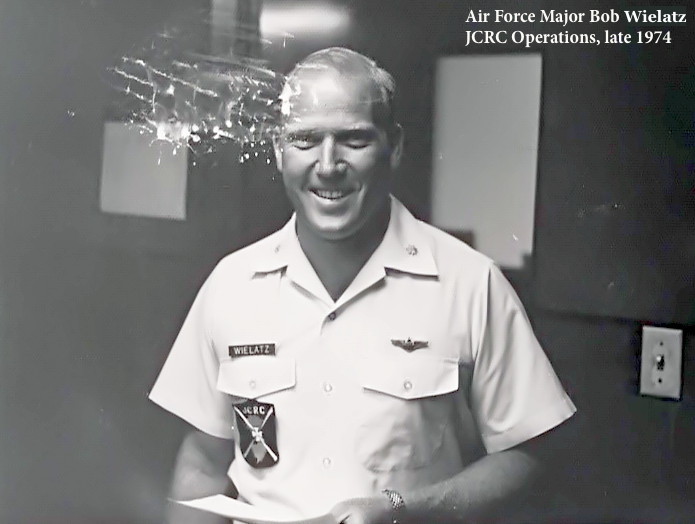
Robert (Bob) Joseph Wielatz passed away on November 14, 2016 due to complications of a heart attack and stroke which occurred on August 18, 2015. Bob was born January 13, 1940, to Joseph George Paluch and Frances Tucker Paluch. Bob's birth father deserted him and his mother when Bob was a baby. Ross Wielatz adopted Bob when he married Bob's mother. Bob graduated from Tooele High School in 1958. He joined the Air Force that fall. After basic training at Lackland Air Force Base, Texas, and Radar Training, in Biloxi Mississippi, he married Connie Smith. He was stationed at Hill Air Force Base then attended Officer Candidate School. He graduated from pilot training school and flew B-52s and FB-111s. He served a total of two and a half years in the Vietnam War receiving the Distinguished Flying Cross for one of his most dangerous and challenging missions.
Bob was an FB-111 Squadron Commander, a Supply Commander, and Assistant to the Secretary of Defense, Logistics. Bob retired as a Colonel in 1990, after honorably serving his country for 32 Ĺ years. After retirement from the Air Force, he worked for Northrup Grumman and then consulted to them on many projects including space systems. After Bob retired for the sixth or seventh time, he enjoyed hunting and fishing with Marv, Ken, and Doug Lee, Sid and Fred Smith, and trips to Wendover with the Lee brothers and Toby and Helen Morgas. He also enjoyed traveling to visit family and friends.
Bob was a positive and loving person. If anyone asked him how he was, he would always enthusiastically respond, "I'm terrific." Bob loved watching Westerns. Everyone who met him would agree, whether in a Western or in real life, he would be the one wearing the white hat. He was one of the good guys. Bob is survived by his wife Connie, daughters Cathy Wielatz, Julie Wielatz, Suzan Bennett, Karen (Tim) Starback, Granddaughters Bridget Stroud and Abby Bennett, Grandson Ryan Starback, and Great Granddaughter Saphira Stroud, Brother Richard and Sister Mary. He was preceded in death by his mother Frances Almeida, Father Ross Wielatz, Step-Mother Hazel Wielatz and Step-Sister Sharon Gotier. A viewing is planned for Friday Nov. 18 from 6-8pm at Tate Mortuary, with a funeral following on Saturday at St. Marguerites Nov. 19, 11am - See more at: http://www.legacy.com/obituaries/saltlaketribune/obituary.aspx?pid=182560702#sthash.eAy3JZFl.dpuf
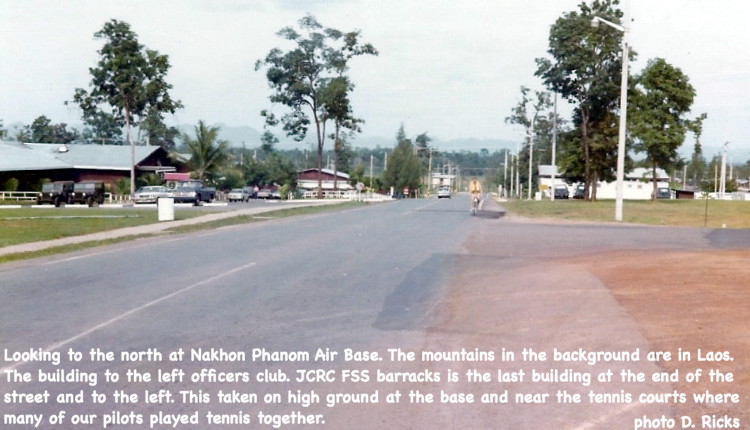
The man in the next to the last photograph above, then Major Robert Joseph Wielatz, is now a retired colonel and a compassionate hero in a quiet and private way. I will forever be grateful for his actions on my behalf immediately preceding the fall of Saigon. Don Ricks
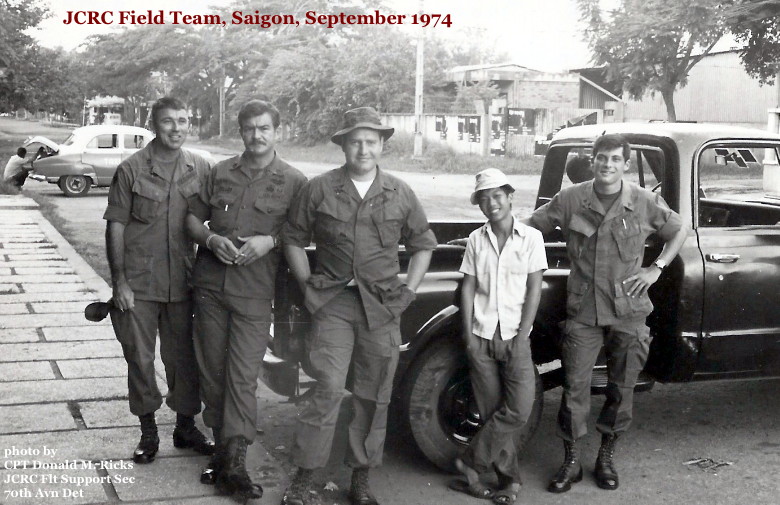
JCRC chain of command staff members shown on the Officer Evaluation Report I received were: LTCOL Charles Ward, USMC, Chief, JCRC Operations Division; LTC Robert F. Wetherbie, FA, USA, Commander, 70th Aviation Detachment; and COL Raymond H. Beaty, USA, Deputy Commander, USMACTHAI/JUSTMAGTHAI.
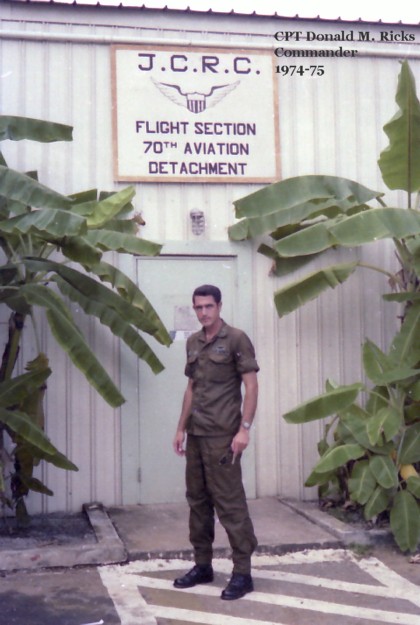
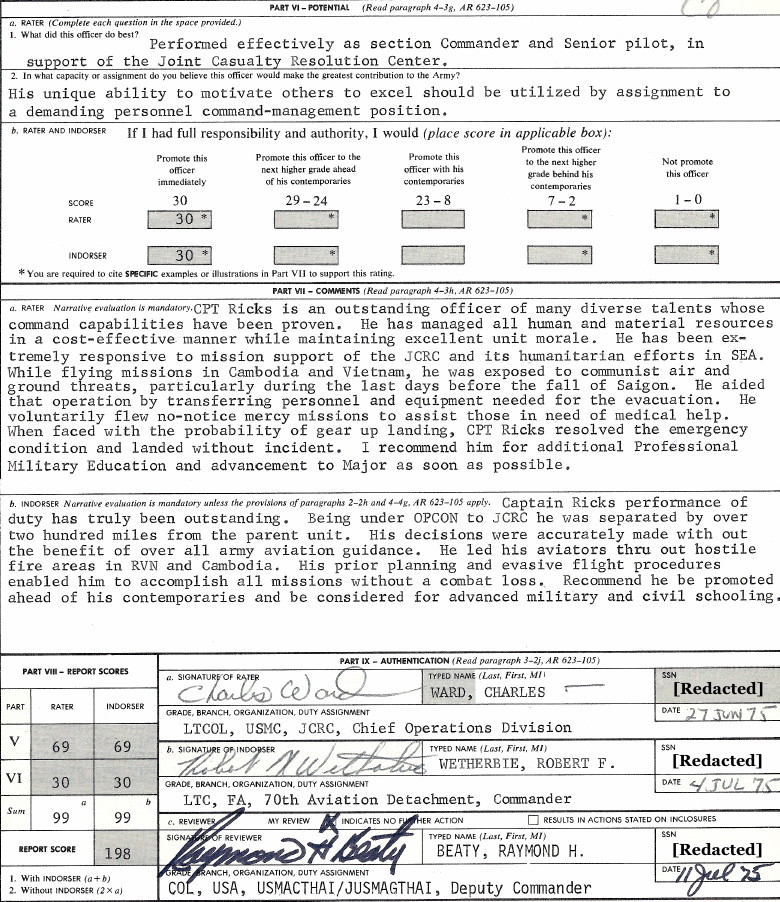
CPT Ricks: “The US Army Officer Evaluation Report above is the only near–perfect one I received during twenty–three years of active service. I share this not to toot my horn but to share the official mission description and the important parts of what we were required to do as a unit—to affirm that it was a team effort from all members of the section, pilots and enlisted men, to accomplish a dangerous and often isolated–from–outside–help missions, which effectively impressed the leaders who wrote and signed my evaluation. We had three U–21 aircraft, and I did not fly any more than the other pilots and crew members. Our maintenance and flight records are reflected in this report too. Good, hard working and professional soldiers doing a near–perfect job are the only justifications for such a report. That being said, consider that when these leaders wrote that I did such and such, they also state that the warrant officers and enlisted men in our Flight Support Section were right there supporting or alongside the pilots and crew as they performed well the most visible missions. There were many unseen exemplary acts of duty, and all well deserve the Meritorious Unit Commendation shown in the general order extract far below.
As I recall, we did not have personnel problems that were brought to my attention. The officers were often gone, which left the section in the hands of our ranking non–commissioned officer. However, as our unit stood down from significant flying missions, orders soon arrived instructing me to prepare the unit for inactivation. All personnel received individual orders for return to the United States or were assigned to other units. One of our enlisted men was not ready for that move and represents the only incident I can recall.
I flew a lot with SP4 James Clark, Jr., MOS 67G20. SP4 David E. Berger was our operations clerk, I believe. SSG Louis E. Fischer (Ed) was the detachment NCOIC. There was a red headed young man (second from the left in the front row below, whose name I can not recall), who kept our flight records in order and was very smart. He picked up Thai in about a month, so well that he could converse with any Thai around. He soon had a girlfriend and was close to her family. When we shipped out he went AWOL and deserted rather than depart country as instructed in his movement orders. I received a request from the post JAG office while at an assignment following my tour, and they had taken him into custody and gave him a courts martial. I was asked to give a statement for his trial—I never knew what happened to him: ”
The following orders were provided by Herbert W. Messman and contain all members of the flight section as we moved to Samae San, effective 1 January 1975:
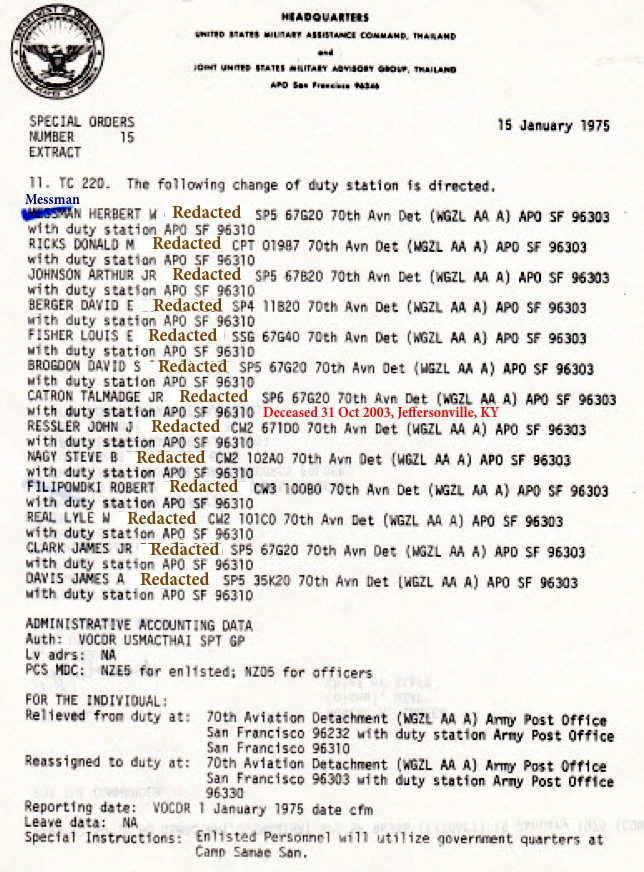

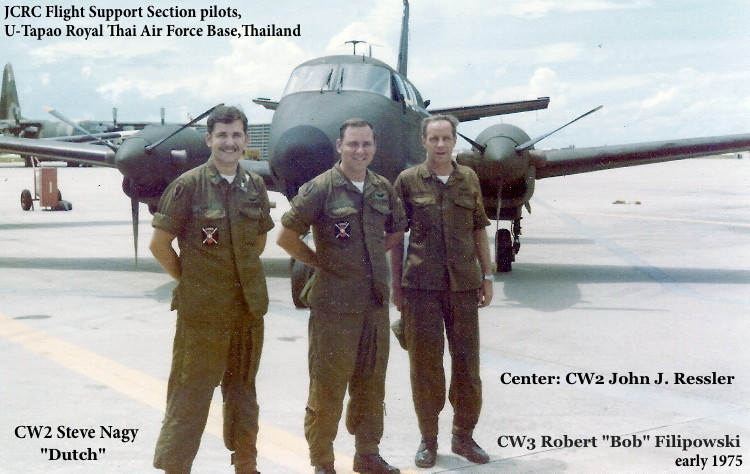
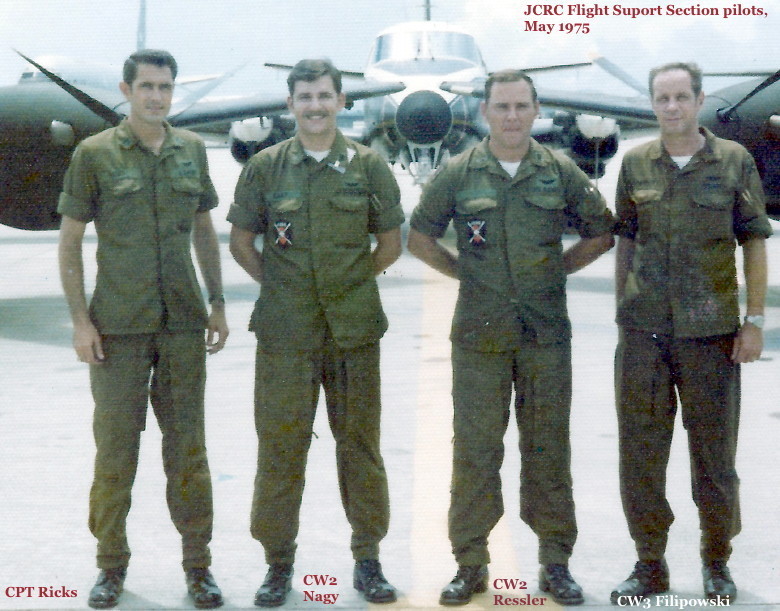

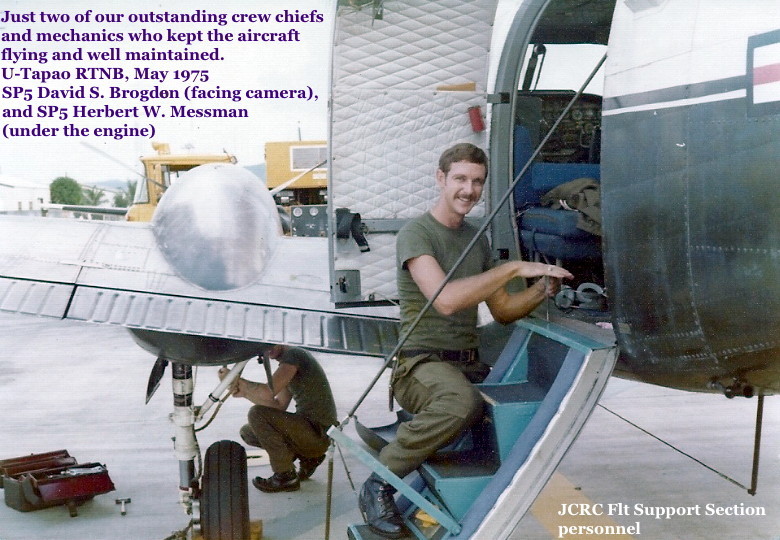
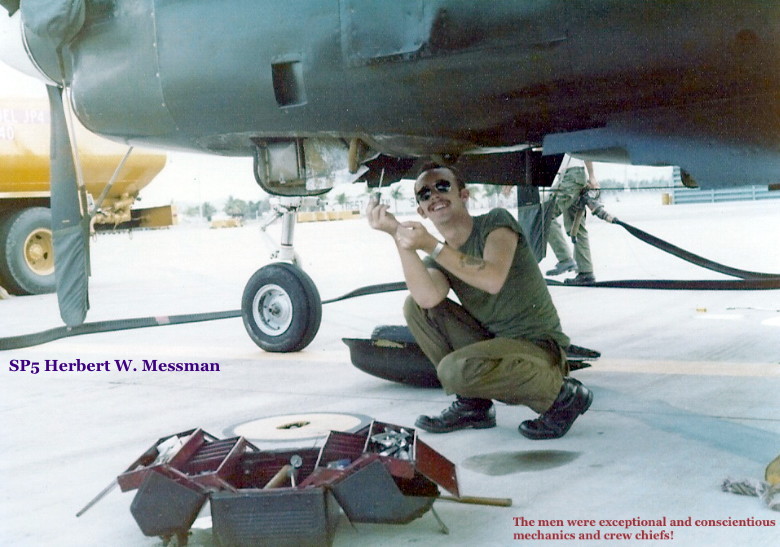
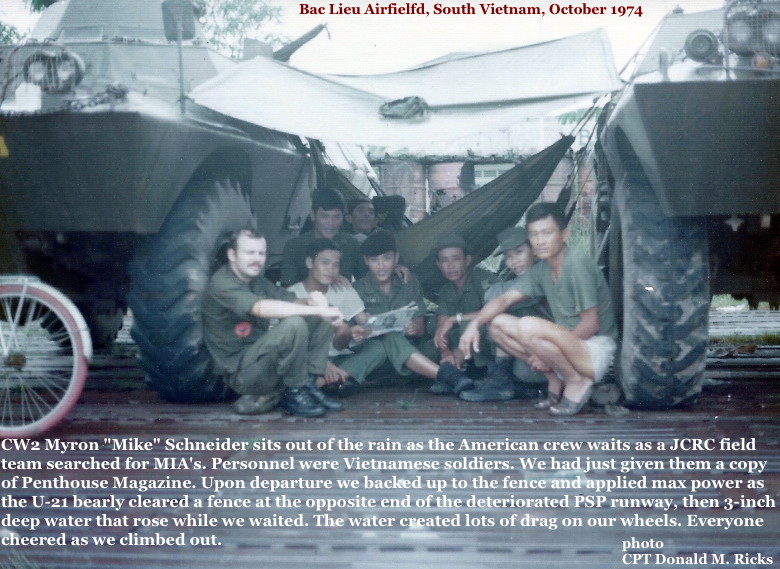
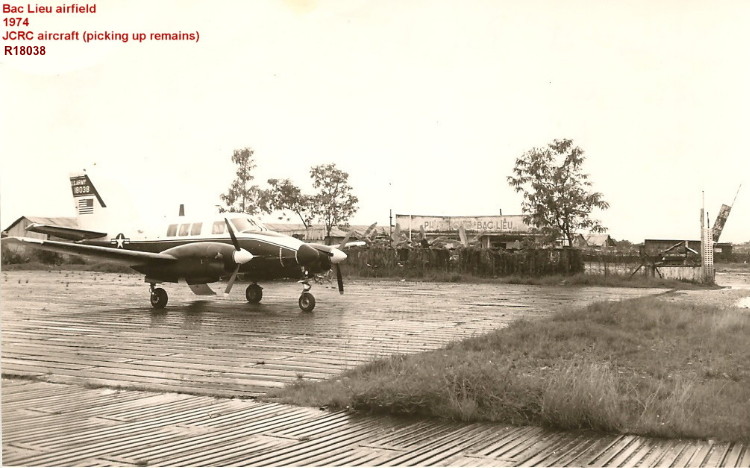
On several occasions, between September 1974 and January 1975, JCRC Flight Support Section took General Ulatoski to Nha Trang for a diplpmatic conference lasting two to three days. CPT Ricks and CW2 Nagy took at least two of those trips. We went as far north as Da Nang on occasion, too. We discovered that not only Bac Lieu and Can Tho Airports were in deteriorated conditions, but also in a sad state of overgrowth and deterioration were the major former American bases at Da Nang and Chu Lai. Nobody asked us our opinion about the state of facilities and equipment but it was obvious to pilots like Captain Ricks, who had flown into all major airfields in South Vietnam during 1969 and 1970 with the Command Aircraft Company, that the country was in a downward slide and in prime condition and weakness for any country in the region to take possession. Unknown to us on a larger scale, that is just what was happening a little farther to the west and north. Aircraft were sitting in revetments at major airports being cannibalized to keep other running—weeds, grass and runways showing obvious signs of neglect were just some of the standout indicators of a country not being able to take care of itself. Saigon’s main airport was amazingly quiet each time we flew into and out of that once bustling center of activity:
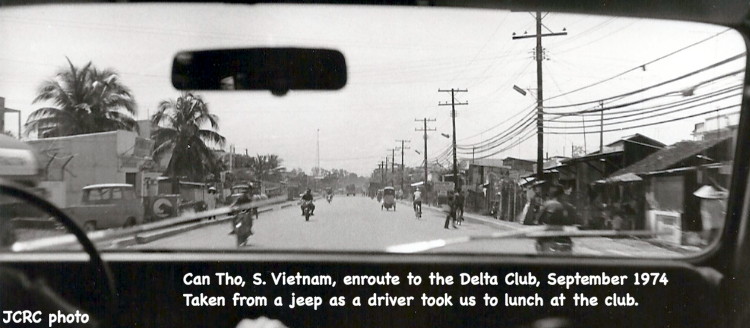
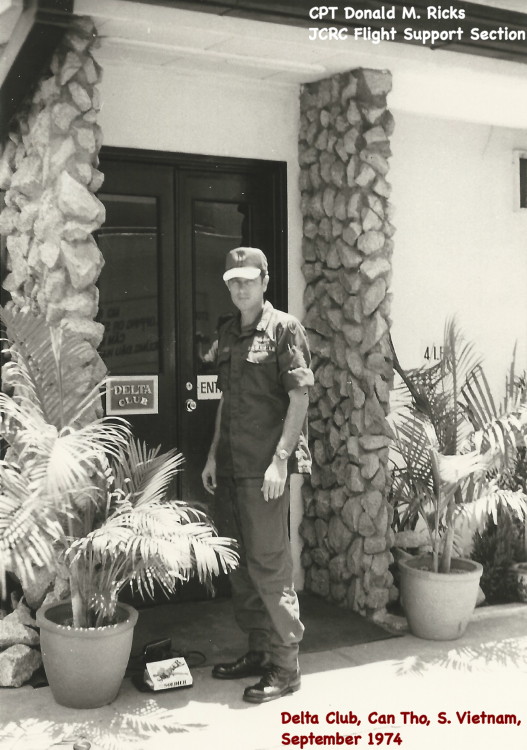
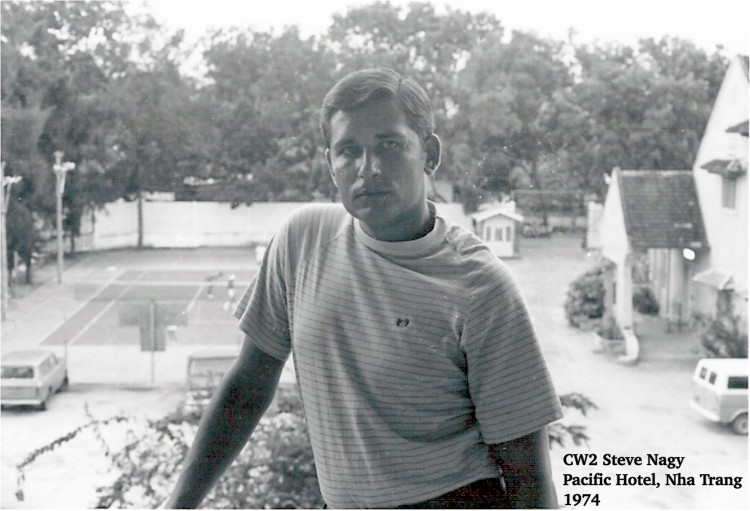
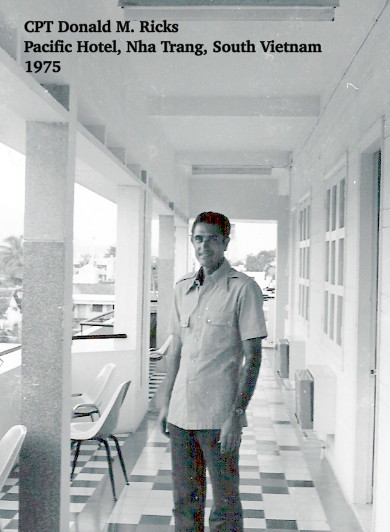
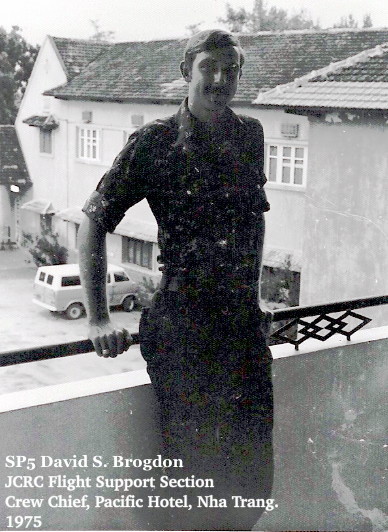
These men probably donít know of this award, but each section member shown in these photographs were awarded a Meritorious Unit Commendation, as shown on the following extract from the order. A unit personnel list previously in the possession of Captain Ricks was lost during shipment to Germany several years after his service in Thailand. If anyone has a similar list, this would assist those men in requesting correction of their military records to include the award:
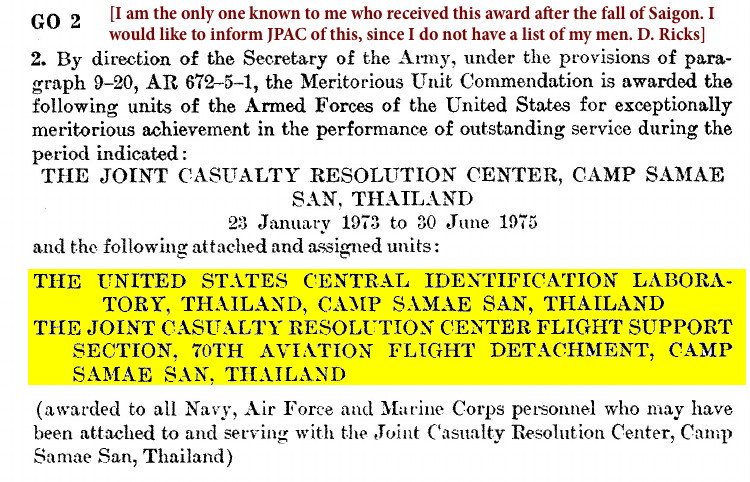
CHIEF WARRANT OFFICER LYLE W. REAL, MARCH 1974–JANUARY 1975:
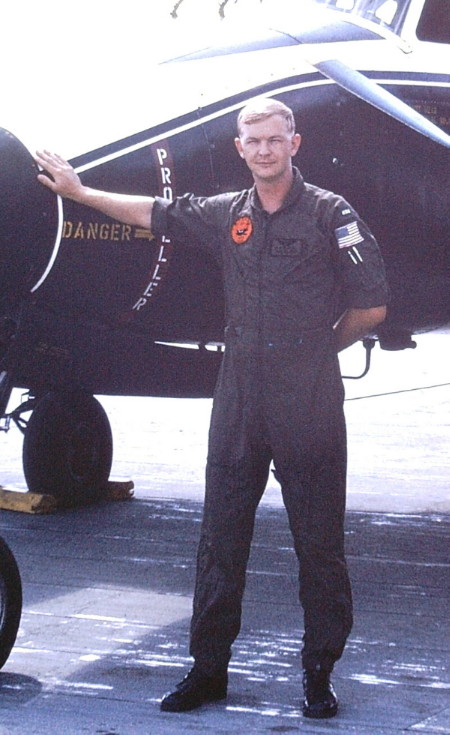
I was originally sent to Thailand January 1974 to fly UH–1’s for the Special Forces in Lopburi. The Thai government threw them out of the country the week I got to Thailand. I was able to talk the Commander of the 70th Avn Co. into giving me an in–country U–21 transition. I was then assigned to JCRC Flight Support Section from March 1974, until the unit moved to U–Tapao in January 1975.
The following photographs are from slides I took and later scanned them. I did not move south with the Flight Support Section as I was leaving country at the end of January. I stayed in Bangkok for a couple of weeks and then went back to the US for an assignment flying CH–54’s at Fort Benning, Georgia:
This photograph shows and identifies some of enlisted men who also served in 1975 as the unit moved south to its assigned base at Samae San:
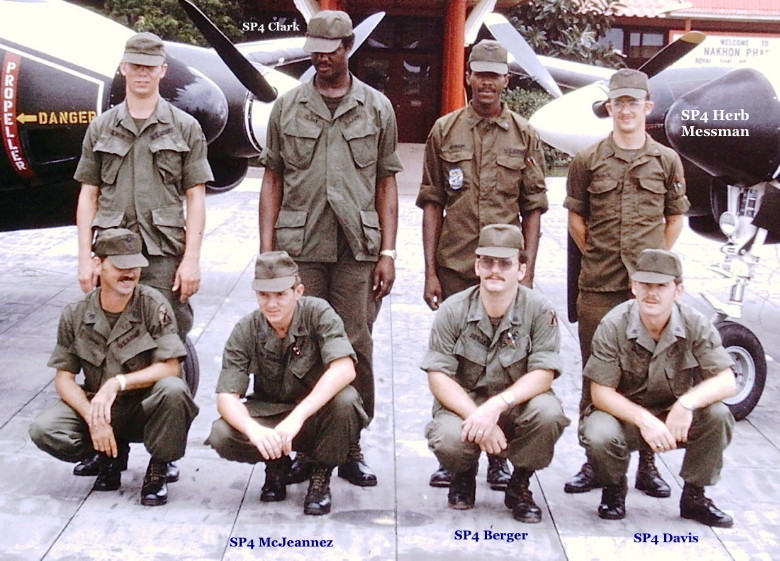
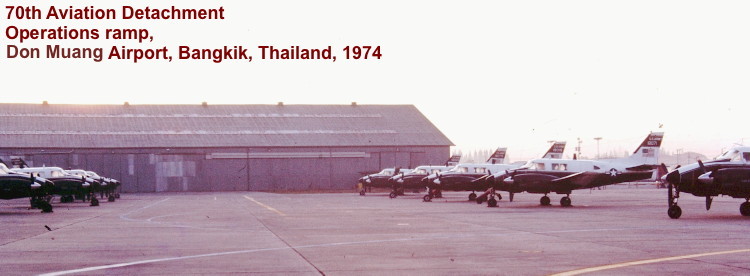

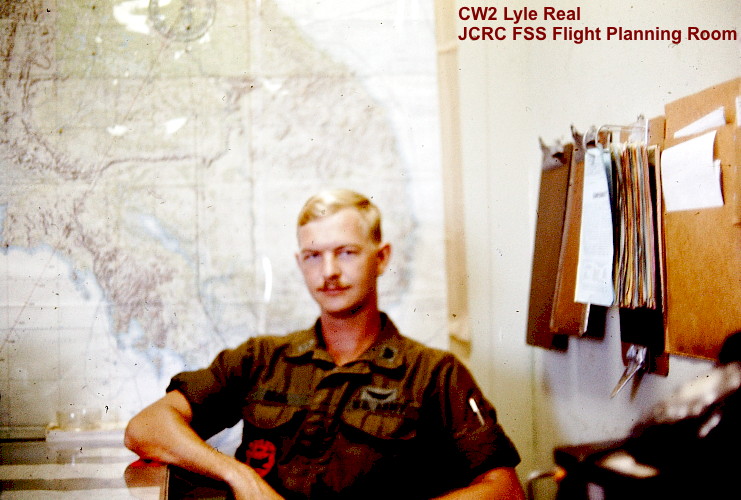

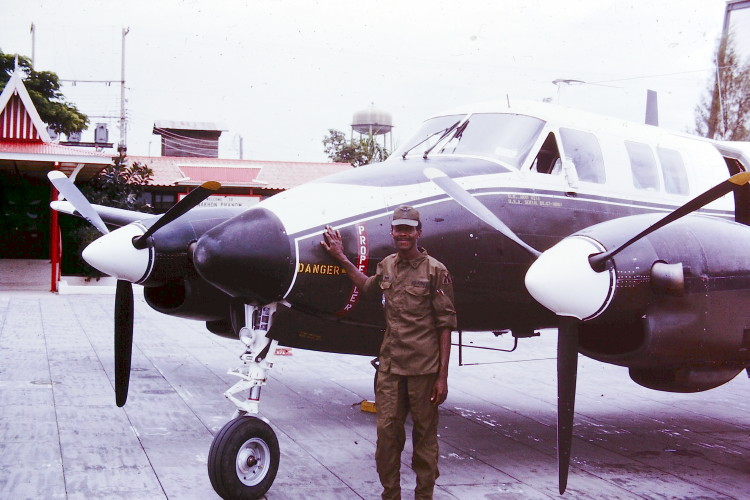
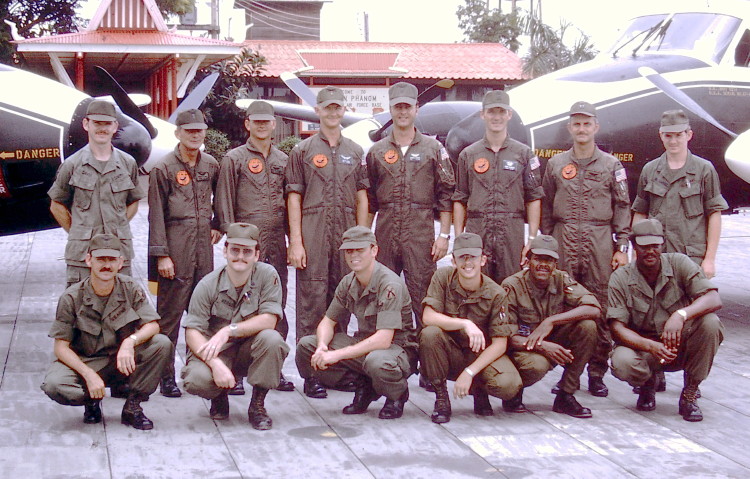
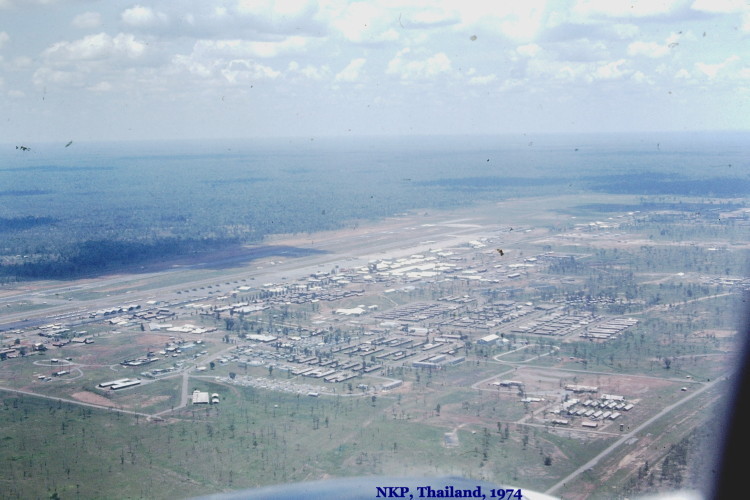
JCRC CHALLENGE COIN AVAILABLE: (14 March 2017)
A few weeks ago I received this email note from Partick Weyand:
Dear JCRC Members:
Greetings! My name is Patrick Weyand. I live in Kenosha Wisconsin and I am a Deputy Sheriff in this community. My father, SgtMaj (Ret) Richard Weyand, was the USMC OPS Sgt at JCRC in 73–74, operating out of NKP and the Saigon office under Col. Esau, Col. Woods, and TAD to Col. Farnham in Saigon. A few years ago, I set out to learn more about my father’s time with JCRC. In doing so, I have been in contact with the Late Maj. Petrie, his son, Col. Esau, Gen. Ulatoski, Maj. Grimshaw, Burks Hunt, Paul Mather. William McCrary, and a few others over the last few years.
I decided to have a challenge coin made to honor and preserve the memories of JCRC. Therefore, with the help of Maj. Grimshaw, Mel Wick, Burks Hunt, and George JR. We came up with the following coin design (please see the attachment).
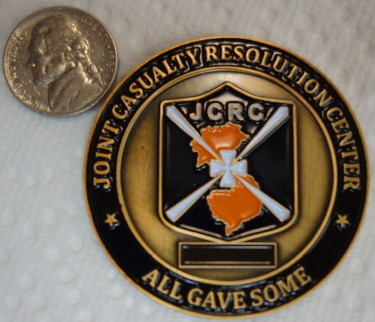
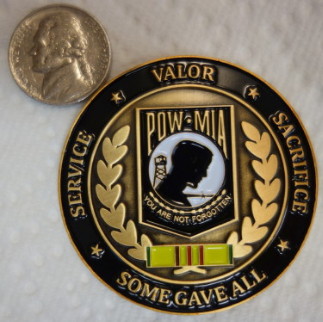
If any of you would like to purchase a coin, please let me know and I will send one out to you. They are $10.00 a piece which basically covers the coin plus shipping. The minimum order that I had to place with the company who made them was 100 pieces. I think that these coins should be in the hands of those of you who served in JCRC. With the help of Burks Hunt and Paul Mather, I have been provided your contact information. I am sending it BCC to protect your privacy. Please let me know if you are interested in ordering a coin and I will get them out to you ASAP. Supplies are limited to the 100 pieces in-hand. I do not intend to have any additional coins made unless there is a great interest to do so. If you do want one please send me a response with your mailing address.
I have attached a photo of the coin. You will notice a black ribbon under the JCRC Logo. That was initially placed there for engraving names at a later date however, a suggestion may be dates or years due to the limited amount of room. I want to thank all of you for your Service to your fellow soldiers with the recovery unit and to our Country.
Best Regards,
Patrick Patrick A. Weyand
7402 2nd Avenue
Kenosha, WI 53143
262-939-9955
patweyand@wi.rr.com
More photos coming soon


